With my sister going to university, we both agreed that it would nice to have a small fridge in the room she’ll stay in. Something small and low noise with enough space to keep a drink (or something like that) cold.
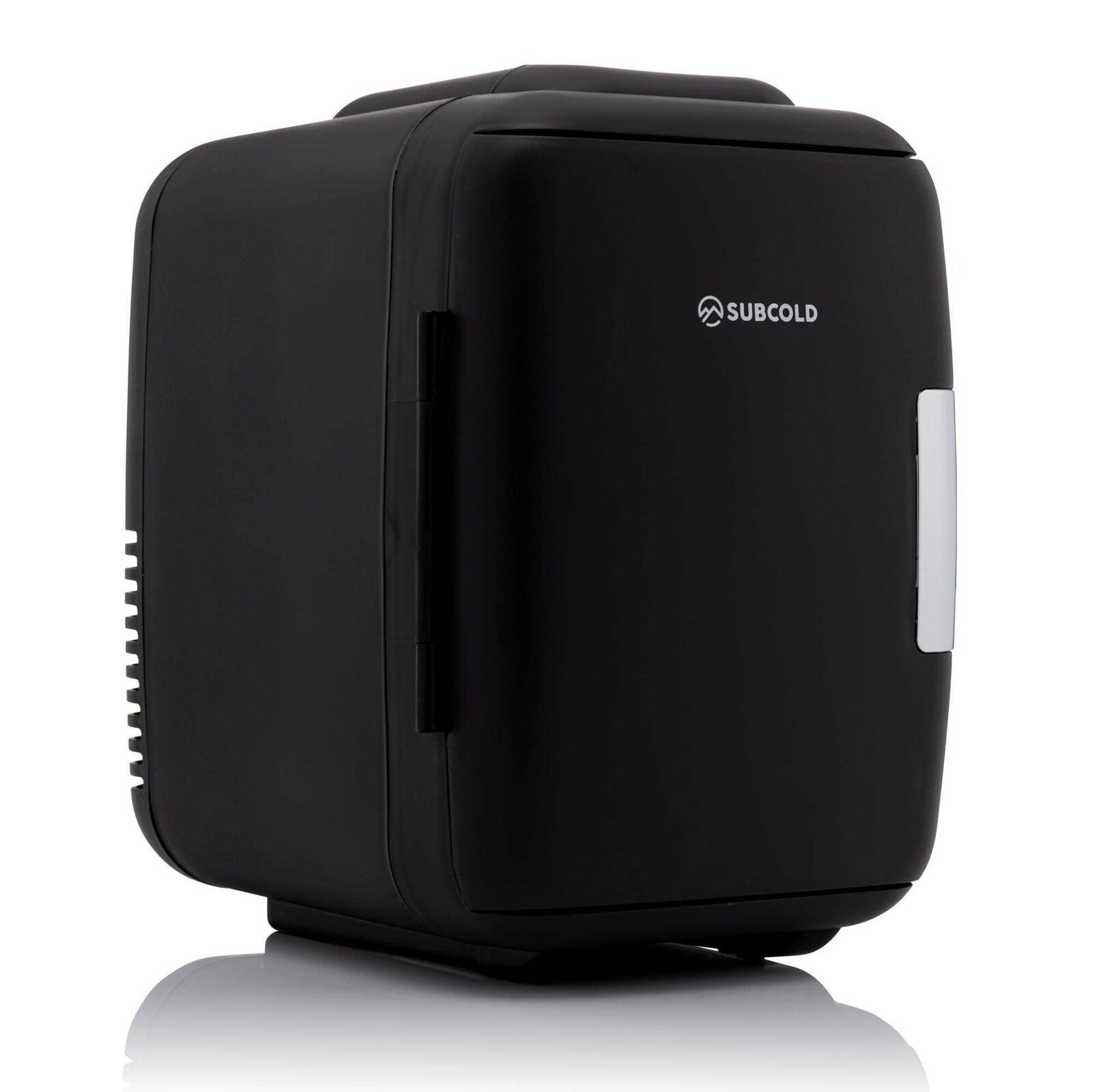
There are many options out there, from proper refrigerators with a lot of space, to very small ones where we can only fit a 33ml can. We ended up getting a Subcold Classic4, which has enough space to store 6 cans inside or “4 litres” of space and should be enough for what she’ll use it for.
I should mention that there are other very similar mini fridges and that this isn’t the cheapest one available. I paid £39 GBP on Amazon UK, (same price on eBay UK, but refurbished costs £30 on the brand’s store) there’s also the AstroAI Mini Fridge 4 Litre that currently costs £34. I didn’t have time to wait for the delivery, but on Aliexpress we can find alternatives like the VEVOR 10L Mini Fridge which looks nice and costs £40 (also a little bit larger) or a very similar copy of the Subcold Classic4 for just £34, although I don’t know if it works as well. Anyway, my point is, there are many similar products to choose from.
Among the reasons we picked the Subcold was its ability to cool and heat up. Another thing that caught my attention was the ability to run from a USB port. I wasn’t sure about how well it would do on that mode, but it’s nice to be able to run it with a powerbank. I think some of the others can also do this as long we have the cable, but they don’t promote it or include the cable. They’re usually sold as something that needs to be plugged into the wall or a car’s 12v socket.
The fridge:
This thing is so simple that there isn’t much to say about it, but a few points:
- It’s small. A quick, not very accurate measurement: 25cm long, 26cm tall, and 18cm wide.
- Everything is made of plastic. Probably one of the reasons why it’s so light.
- The door is kept in place with magnets, so that bit that looks like a handle doesn’t really do anything. To open the door, pull the side towards you.
- The power cable is plugged at the back. There we’ll also find a switch with 3 positions: cold, off, and hot. There are 3 “openings” for air flow (there’s a fan inside).
- At the top there’s a handle to pick it up and 4 rubber feet in the bottom. That’s it.
- Inside there are two shelves. One on the door and one almost at the top of the fridge. Both are small (so is the fridge) and removable.
- It doesn’t seem to be very well insulated, but it works.
- The fan is very quiet, but we can definitely hear it, especially when running at higher power/connected to the wall socket. USB mode is much quieter.
- It runs continuously. No pauses after reaching a certain temperature (that I noticed).
- This model comes with a USB-A cable and the wall adapter (UK in my case).
Regarding the noise, how audible it is will depend on what’s around the fridge, how close we are to it, and if we’re easily annoyed by these low noises or not. It’s probably not something I’d want to have next to my bed, but it’s probably fine a few meters away.
I’ll just say that they probably could have done better. The fan seems to be similar to what we can find on a computer tower and those can be pretty quiet. I’m not going to upgrade it, but yeah, it could be better.
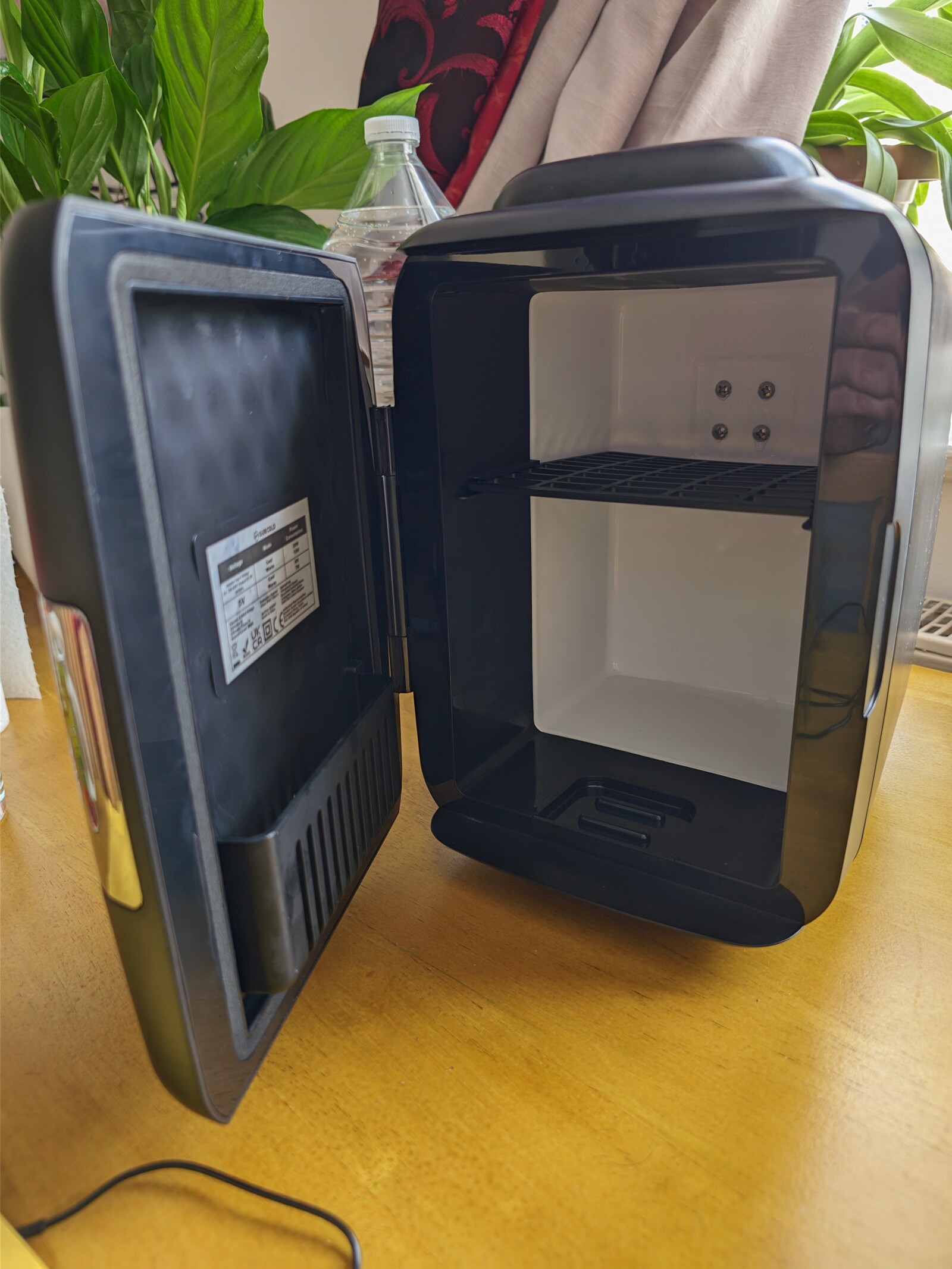
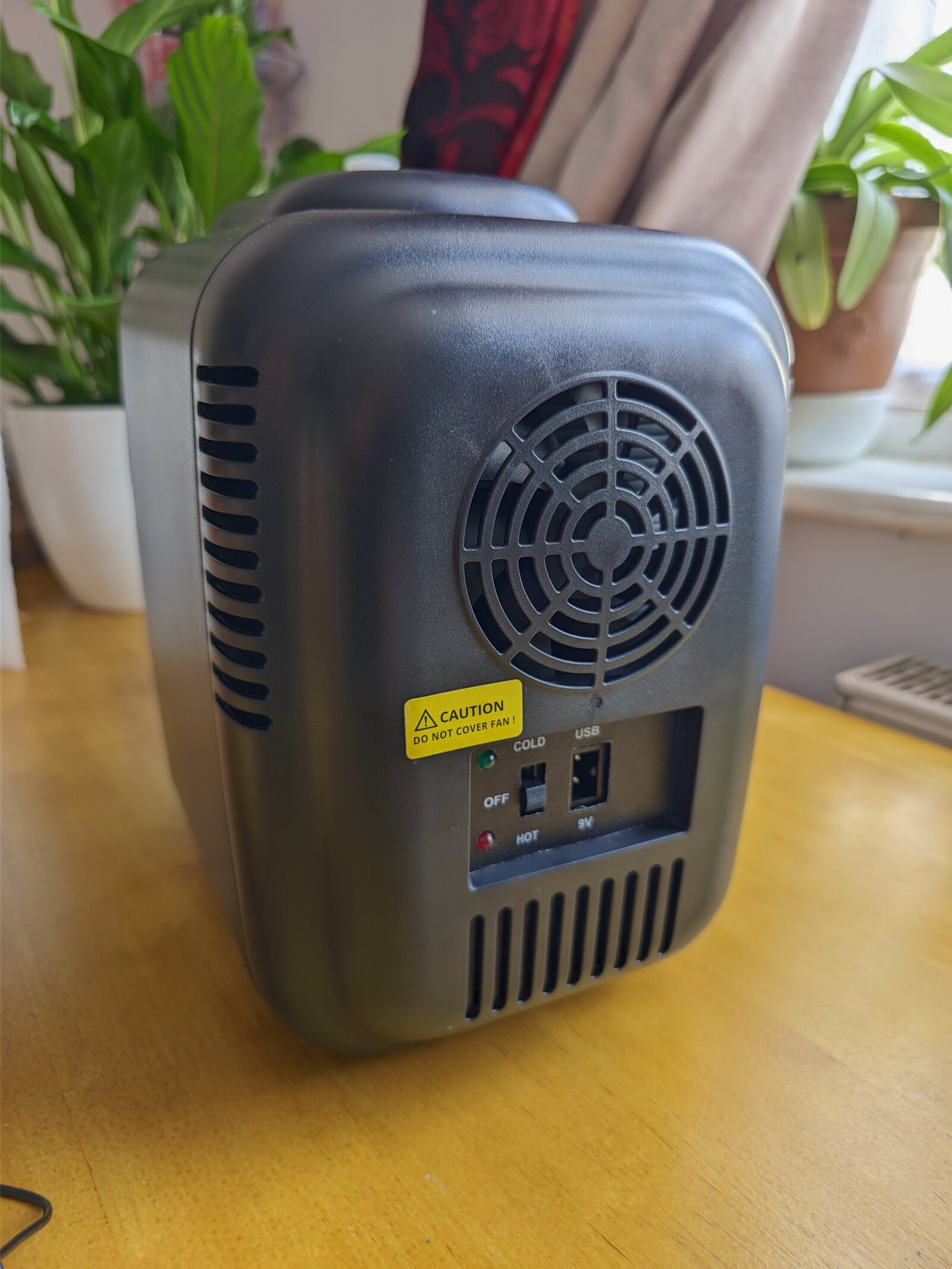
How does it work?
This fridge (and the alternatives linked above) doesn’t use a compressor or refrigerants like a normal fridge. Instead, it uses a thermocouple.
Wikipedia has a good explanation of how it works[a], but essentially there’s a plate and when power runs through it, heat is transferred from one side of the plate to the other, making one side very cold and the other very hot. When you’re using it in cooling mode, the cool side makes the inside of the fridge cold, while the other side gets hot and is cooled with a fan on top of a heat sink. (I assume that the hot mode uses the same system, but in reverse.)
The main limitation of this method of cooling is that how well it performs depends on the ambient temperature. Their claim is that it can get 18ºC below ambient temperature (or 10ºC on ECO/USB mode) or between 45-65ºC on hot mode.
Measuring the temperatures
These are not very accurate tests and I tested it on hot days (for London, at least). The room temperature was between 24 and 26ºC (31ºC outside, no air con, windows closed because of a fire nearby… not ideal).
I used 4 thermometers that are accurate-ish (“+/- 0,5%”), 2 to measure the temperature inside and 2 to measure ambient temperature. I ignored decimal points and rounded the temperature to nearest number (average of both probes).
Since the cables don’t allow the door to fully close, I used some paper tape around the door. Some performance may have been lost because of this.
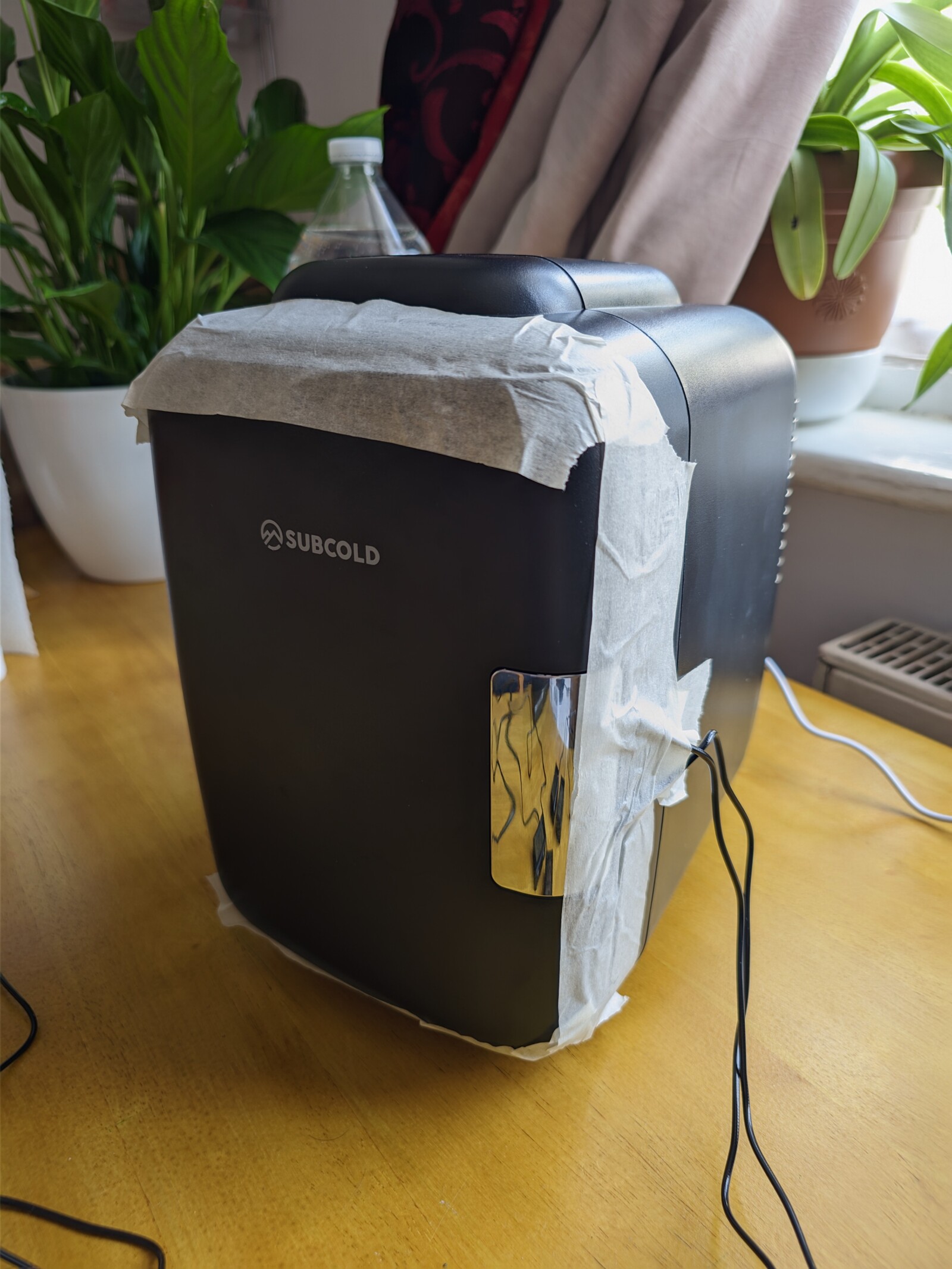
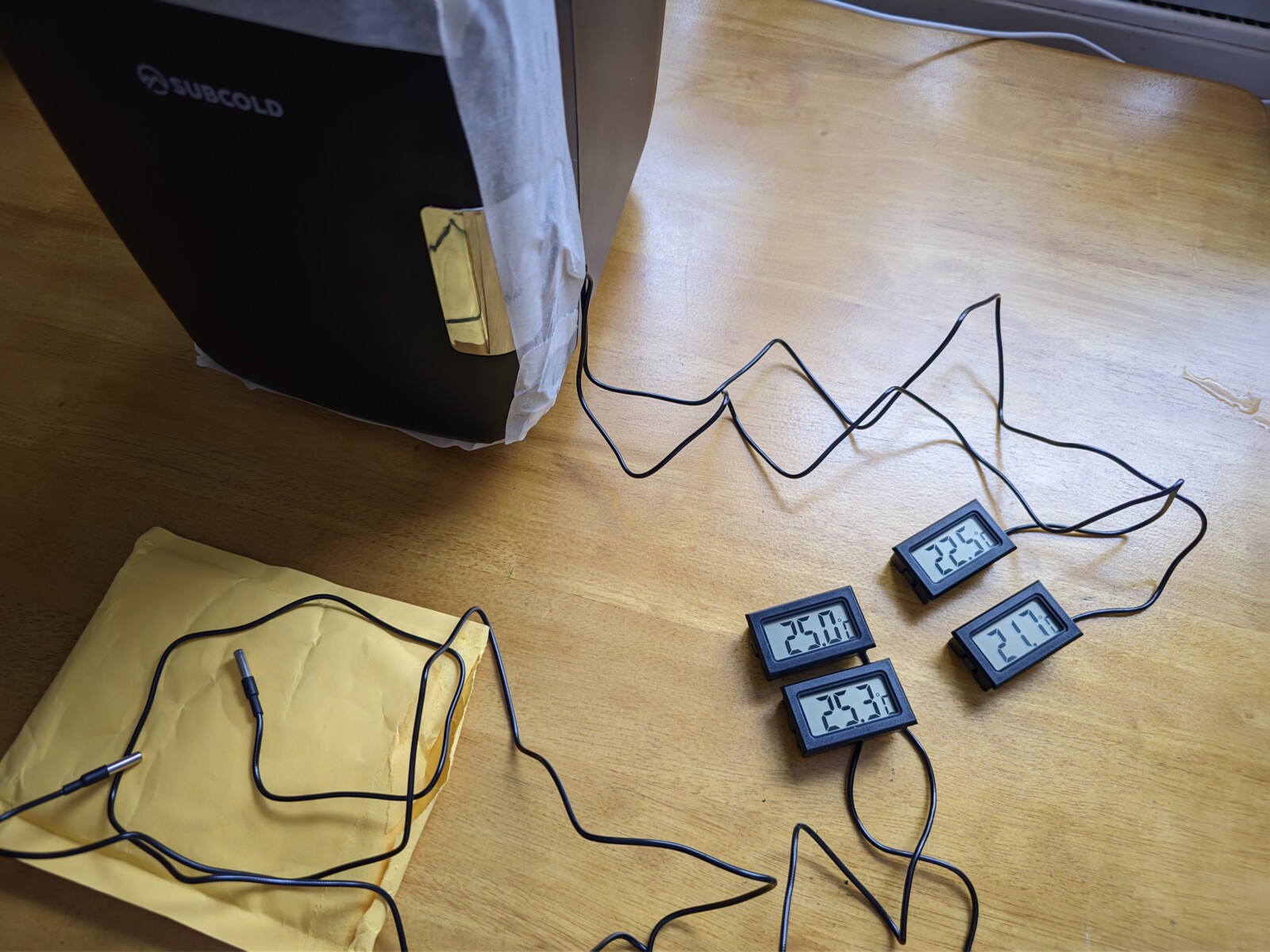
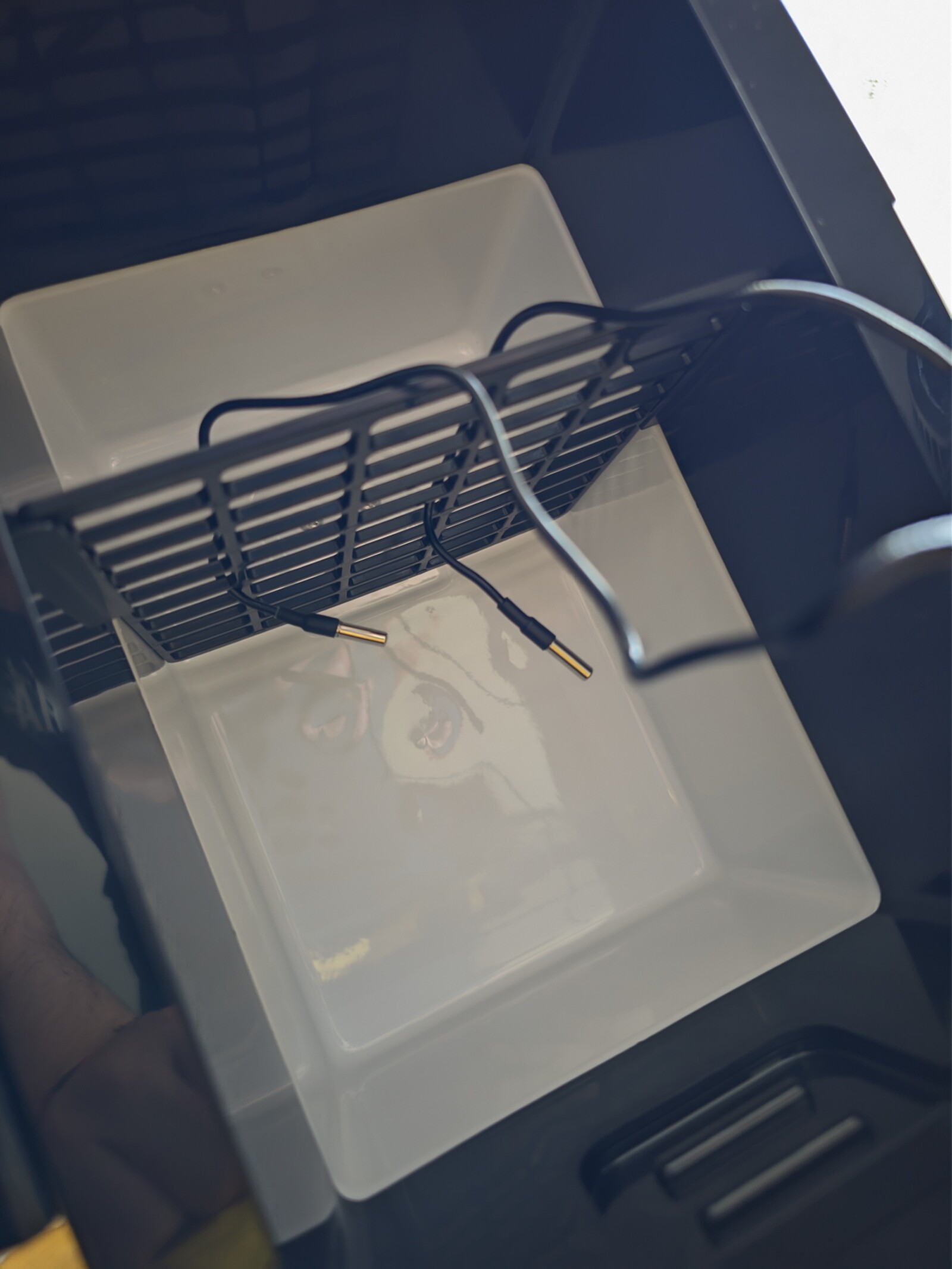
With the wall adaptor:
Cool mode ❄️:
- Claimed to go up to 18ºC below ambient temperature. Managed to get 14ºC below ambient.
- Claimed to use 20W. Started at 22W, but quickly dropped and settled at around 19W while cooling (power meter).
| Time | Temperature fridge | Ambient temperature | Inside vs Outside |
| Start | 27ºC | 27ºC | 0ºC |
| 15 min | 16ºC | 26ºC | -10ºC |
| 30 min | 13ºC | 26ºC | -13ºC |
| 1 hour | 12ºC | 26ºC | -14ºC |
| 3 hours | 12ºC | 26ºC | -14ºC |
| 6 hours | 12ºC | 26ºC | -14ºC |
It had reached its lowest temperature by the 1 hour mark.
Hot mode 🔥:
- Claimed to be able to go up 65ºC. Managed to go up to 61ºC.
- Claimed to use 15W. Started with a peak of 23W, but quickly dropped and slowly settled at around 15W (power meter).
| Time | Temperature fridge | Ambient temperature | Inside vs Outside |
| Start | 27ºC | 26ºC | +1ºC |
| 15 min | 43ºC | 25ºC | +18ºC |
| 30 min | 49ºC | 25ºC | +24ºC |
| 1 hour | 58ºC | 25ºC | +33ºC |
| 2 hours | 61ºC | 25ºC | +36ºC |
| 3 hours | 61ºC | 25ºC | +36ºC |
It had reached its higher temperature by the 2 hour mark, although it was pretty close after 1 hour.
With USB (ECO mode):
I used the included cable and a ASUS 18W USB charger.
Cool mode ❄️:
- Claimed to be able to go up 10ºC below ambient temperature. Managed to get 9ºC below ambient.
- Claimed to use 6W. Started at 8.5W and then settled at 6.7W while cooling (power meter).
| Time | Temperature fridge | Ambient temperature | Inside vs Outside |
| Start | 26ºC | 26ºC | 0ºC |
| 15 min | 22ºC | 25ºC | -3ºC |
| 30 min | 20ºC | 25ºC | -5ºC |
| 1 hour | 18ºC | 24ºC | -7ºC |
| 3 hours | 15ºC | 24ºC | -9ºC |
| 6 hours | 17ºC | 26ºC | -9ºC |
It had reached its lower temperature by the 3 hour mark. Both inside and outside temperatures had increased 2ºC when I checked it at the 6 hour mark (still 9ºC under ambient).
Hot mode 🔥:
- Claimed to go up 45ºC. Managed to go up to 42ºC.
- Claimed to use 7W. Started at 8.7W and then settled at 6.5W while heating (power meter).
| Time | Temperature fridge | Ambient temperature | Inside vs Outside |
| Start | 25ºC | 24ºC | +1ºC |
| 15 min | 35ºC | 25ºC | +10ºC |
| 30 min | 39ºC | 25ºC | +14ºC |
| 1 hour | 41ºC | 25ºC | +16ºC |
| 2 hours | 42ºC | 24ºC | +18ºC |
| 3 hours | 42ºC | 24ºC | +18ºC |
It had reached its highest temperature by the 2 hour mark.
My thoughts
Overall, the mini fridge seems to do what it says on the box. No complaints so far.
It needs time to cool down things. For example, a small water bottle takes at least 1 or 2 hours to go from room temperature to being cold. For it to be really cold, it needs more time, maybe 6 hours or so. Obviously it will be colder after 30 minutes, just not fridge cold. This is to be expected from this type of product and I’m only mentioning it so no one thinks it performs as well as a 800W fridge.
It’s clear that we need to plug it to the wall for it to perform better and faster. Before this test, I left a can of Coca-Cola and a bottle of water overnight, first with USB and then with the wall adapter. While both were cold when I took them off in the next morning, it wasn’t very cold when I used USB power. With the wall adapter, it gets much closer to something that comes out of my fridge (I measured the temperature inside the mini fridge – after opening the door to put the probe inside – and it was at 7ºC with an ambient temperature of around 22ºC). The only time I can see USB mode really cooling stuff down is when the ambient temperature is already low.
With this said, USB mode is still useful to keep things cold for longer periods. For example, if I’m going on a car trip and want to have cold water bottles, I just have to put them in the fridge and then carry them in the mini fridge as it will stop them from getting warm quickly. Since it can be powered with a powerbank, it can also be useful in case of a power outage as it allows us to keep a few things cold (or hot) for while. This fridge is also promoted as something to store makeup products that work better at lower temperatures, but don’t need extreme cold, so I assume USB mode is good for that too.
While we bought this mostly for cooling, the heating mode is also useful. With temperatures slightly above 60ºC, you can easily keep something warm for a while.
I can see this not working that well for those in hotter climates. 26ºC indoors is common in parts of the world, but for me it only reached that temperature because we had a few days with temperatures above 30ºC and I couldn’t open the window (or use my portable air conditioner) due to the smoke from a nearby fire. I recommend testing and looking for feedback from other users in your region to see what they say about these products.
Nothing else to add. I’ll update this section if any problem arises.
[ While the links above are affiliate links to Amazon/eBay/Aliexpress, I bought the fridge myself. This is not a paid review. ]